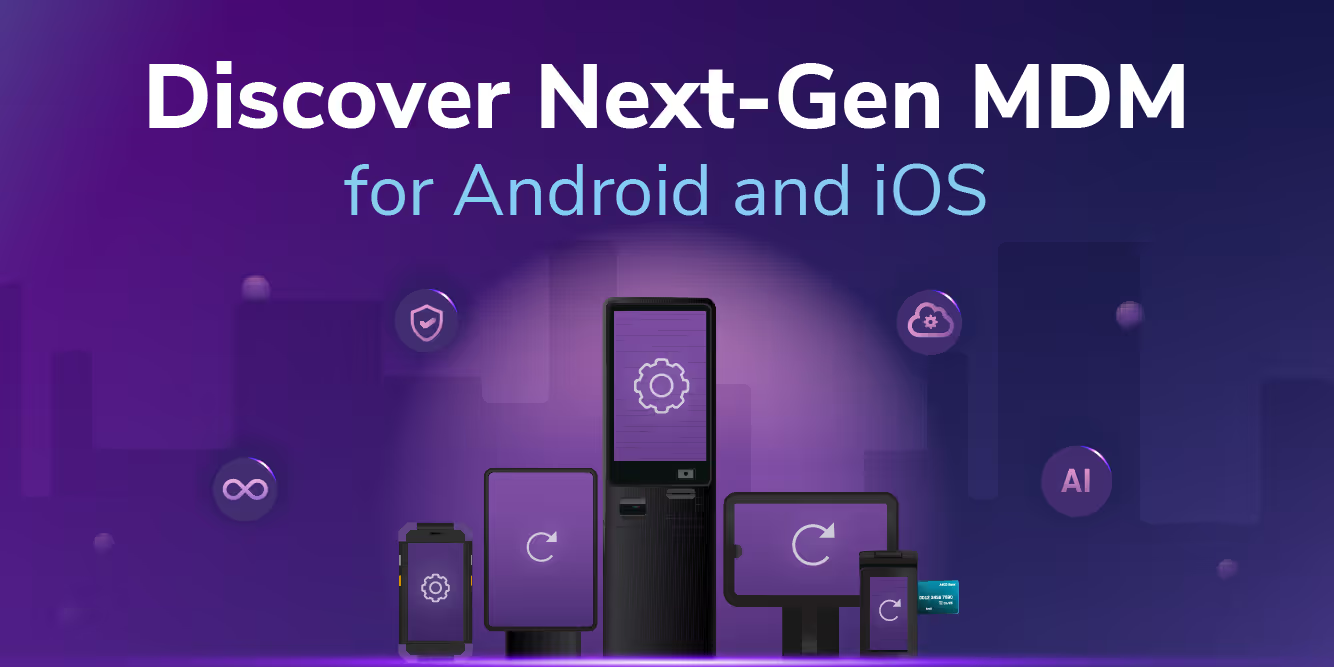For decades, point-of-sale (POS) hardware has followed a set recipe — payment is handled via an external terminal providing a card reader with a PIN pad. If you’re a kiosk builder or vertical device OEM, that has meant carving out space for smartly placed USB ports, considering payment terminal mounting points, and potentially partnering with payment ISVs.
But that model is being cracked open. And the catalyst is SoftPOS, a software-based payment acceptance that can turn any NFC-equipped device into a certified, tap-to-pay terminal. While SoftPOS has been lurking the last few years, it's now coming up as device makers specify their next-generation POS and kiosk hardware. As this design target gains momentum, the strategic implications are massive for the entire POS ecosystem — from silicon vendors to enterprise customers with POS and kiosk fleets.
What is SoftPOS (and Why It’s Not “Just Another SDK”)
SoftPOS (Software Point-of-Sale) enables tap-to-pay and PIN entry directly on commercial off-the-shelf POS and kiosk devices — as well as phones and tablets — using nothing but software, a secure hardware root, and NFC.
At first glance, it sounds like a developer feature. But it’s not. SoftPOS shifts responsibility and value up the stack:
- OEMs and ODMs must now design for compliance, not just performance.
- Terminal vendors are in the midst of driving a fundamental shift in their product lines.
- Retailers and restaurants can rethink every checkout form factor.
- MDM providers (hi, that’s us at Esper 👋) can track payment system status and health as a core device capability instead of treating it as a peripheral.
And for those wondering about the behemoths: Apple’s doing it. Google’s doing it. Samsung is monetizing it. PCI has blessed it. This is happening.
SoftPOS, PIN on Glass, and the MPoC Standard
SoftPOS owes its legitimacy to PCI MPoC (the Mobile Payments on COTS standard), which evolved from earlier attempts like CPoC and SPoC. The breakthrough was PIN on Glass, securely capturing card PINs directly on a device’s touchscreen.
This unlocks the capability to conduct debit transactions (which require PIN) while maintaining EMV compliance without external PIN hardware. From a business perspective POS OEMs can absorb the traditional payment terminal into their POS hardware for most retail and restaurant needs upon hardware refresh.
But it also comes with baggage including mandatory secure hardware elements, remote attestation (OS version, patch level, boot state, app integrity, etc.) with a corresponding monitoring service, and the requirement for delivering quarterly security updates with compliance audits (which you’ll notice sound very GMS like).
As you can see, SoftPOS isn’t “drop an SDK and go.” It’s a regulated subsystem bringing with it a business model shift for the entire POS ecosystem.
Bill of Materials, Design, and Platform Shifts: What OEMs Need to Know
If you build POS systems, kiosks, tablets, or handhelds, SoftPOS will impact everything from your hardware design to your supply chain. The table below illustrates the main impacts for device makers.
The standard “Android POS device + USB card reader” implementation is now becoming outmoded. POS devices must be designed for secure payments or risk being locked out of the market by compliance.
Who Gets Paid Now? Economics of the SoftPOS Stack
SoftPOS also reshuffles who gets paid per transaction. In the traditional model, terminal vendors (Verifone, Toast) could monetize by bundling hardware and a payment provider, then taking a cut of the transaction. Merchants were often locked into long-term acquirer contracts bundled with the hardware.
With SoftPOS, OEMs (e.g. Samsung, Google, or any POS vendor) can now partner directly with SoftPOS SDK providers and take a cut of each transaction. The SDK provider (Stripe, Adyen, Ingenico) handles payment orchestration and merchant enrollment. The upshot is enterprise buyers can unbundle the stack choosing their acquirer separately from the hardware.
But this introduces new complexities into the ecosystem. OEMs must navigate SDK partnerships carefully, as picking just one limits flexibility, while picking many expands the support burden. At the same time, Enterprise CTOs want control, not another source of lock-in. SoftPOS introduces a negotiation layer OEMs never had before, involving interchange, processing fees, and revenue share mechanics.
Is it worth it? It may be for POS OEMs with global reach and the financial systems to handle this different type of revenue stream. It's a big effort as OEMs will need legal, compliance, and strategic alignment to pull it off.
Platform Power Grabs: Apple and Google Take Their “Cut” at It
When the behemoths of the industry get together to set new standards, you can be sure they are ready to take advantage of the resulting industry changes.
Let’s start with Apple:
Tap to Pay routes all transactions through Apple Pay, locking merchants into its payment flow. Even if you use Stripe or Square, Apple takes a slice of interchange via the wallet rails. Retailers can’t route around Apple. No alternative SDKs. No OS-level customization. What you see is what Apple says you get. Using an iPhone to take contactless payment on an iPhone has been around since 2022 and is available in a limited number of countries.
What about the iPad? That is the most direct competitive hardware platform to the traditional POS OEM market. Yet the current generation of iPads are incapable of supporting SoftPOS — they don’t include NFC reader hardware in the BOM, and don’t support the Tap to Pay API. Keep a close eye on the next generation of iPads to see if Apple brings iPad to the SoftPOS party.
Then there’s Google:
Android SoftPOS is gated behind Google Play Services and AMAPI. No DPC-level toggle is provided via the low-level Android management APIs. Rev share with OEMs is not guaranteed unless you partner with Google Pay Merchant directly. Google’s SDK is convenient as they build for the developer experience, the tradeoff is: You give up control in return for speed. Plus AOSP is left out, putting pressure on OEMs to put all their Android chips in the GMS basket at the expense of customers that prefer AOSP over GMS.
Apple and Google SoftPOS may work for small merchants or startups. But enterprise retailers and restaurants don’t like losing leverage. If Google or Apple inserts themselves too aggressively, there’s risk of backlash with OEMs caught in the middle. If that revolt happens, OEMs may be forced to rip and replace their SDKs or backpedal GMS adoption — a nightmare for any roadmap planned 18 months out.
Strategic Shockwaves — Who’s Most Affected?
OEMs and kiosk builders:
Top of the impacted list are vertical market OEMs and kiosk builders. This is a once-in-a-decade architecture pivot. SoftPOS eliminates dongle costs, but adds a compliance surface. Expect that you’ll have to ensure your hardware design, including key component selection, is SoftPOS-ready. Then your hardware platform will need to be certified. From a sales perspective, you’ll have a new area to discuss: per-transaction revenue, preceded by negotiating partnerships with payment SDK providers.
The old “sell-and-walk” model is fading. Now you’re in recurring revenue territory if you can navigate compliance and SDK partnerships, and have the financial systems to take in this different revenue stream.
Terminal OEMs:
Terminal OEMs are at a crossroads. The terminal brick is no longer a requirement, and there’s new competition on the horizon from a Samsung tablet or Pixel phone with MPoC certification. Terminal OEM can become an SDK vendor, license their stacks to OEMs, or pivot to backend orchestration with value-added services. Verifone is already there. Toast? Still a wild card, but the writing is on the wall.
Vertical market ODMs and silicon vendors:
Vertical market ODMs and silicon vendors are entering new terrain. Their value will need to expand beyond just board design and manufacturing, adding in compliance support such as passing SoC attestation, offering TEE + SE in a validated reference kit, and demonstrating competency in NFC tuned for glass thickness and interference.
“MPoC-Ready” will be a buying criterion by 2026. Qualcomm and MediaTek are already there based on their traction in the consumer smartphone market. Rockchip and UniSOC? Not yet, and kiosk OEMs relying on them will feel the heat.
CTOs & Tech Leaders:
If you are an Enterprise Retail or Restaurant CTO, SoftPOS gives you an exit ramp from aging card terminals and brittle integrations. It simplifies field service by exposing fewer failure points, provides the opportunity to pull what a capability category that was previously estate managed into your device fleet’s management plane, and impacts the fundamental cost structure of the enabling hardware and the interchange fees.
Lunch is not free though — you'll need to track who gets paid and why — Apple, Google, OEM, or your processor? You also run the risk of adopting a SoftPOS SDK that is too rigid or platform-tied, leading to losing leverage over acquirers. Plus, a set of new design requirements is introduced for your new POS hardware tenders that were previously taken care of by the terminal providers. It’s now on you to consider TEE, SE, and certified attestation stack in addition to the traditional target specs for things like screen size and touch performance.
Some OSes Are More Ready than Others…
SoftPOS isn’t just a feature toggle. It’s a stateful, monitored subsystem with controls and obligations that tie into the management infrastructure provided by the underlying OS powering the devices. Here’s a table that breaks it down by the major OS variants.
You can see who’s ready — Apple with the iPhone and Google with GMS powered by MediaTek and Qualcomm silicon. AOSP is currently left out, while Windows is behind. This doesn’t mean you can’t implement SoftPOS on AOSP or Windows, but it does mean you have to chain together the right partner set to get this done, much like HP has recently done with Felix Payment Systems. The Linux community does not appear to be focused on this space right now. Note: This is all based on publicly available information; perhaps more is going on behind the scenes.
Risk Begets Reward
SoftPOS is much more than an app — it’s a subsystem with certification, hardware roots, and audit requirements. Devices will need full TEE implementations; shipping a device with TrustZone is insufficient. Linux and Windows are at a disadvantage here, with GMS leading the way and work to do for AOSP. Qualcomm and MediaTek are ready to go for PIN-on-Glass with TEE support, while Intel and AMD have TEE implemented on select processor lines. Make sure you are up on everybody’s NDA roadmap briefings!
What should you walk away with from this blog? SoftPOS is a platform shift, not a feature drop. PIN-on-Glass requires SoC and OS-level compliance, and including NFC in your hardware design is just the start. OEMs can monetize the transaction, but only with the right SDK partner and the financial systems that can handle this type of revenue stream. Of course, Google and Apple are angling to take their own cut, and that’s raising red flags — are we heading to another app store situation with transactions? From that major, retailers and restaurant operators will push for control, pushing OEMs to design for optionality.
Yes, it is going to get even more complicated. If you need help evaluating your SoftPOS readiness, give us a shout. Whether you’re building devices, deploying them, or somewhere in between, we’re here to help. Let’s future-proof your roadmap together — book a demo or contact us to get started.
FAQ
Keep Exploring







.avif)









